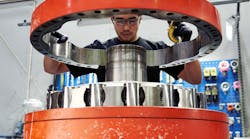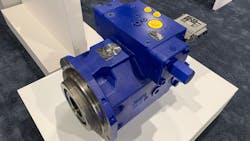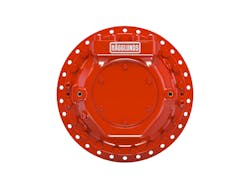Marine and offshore applications are among some of the harshest, necessitating use of components which can meet the levels of performance and durability required. During the Offshore Technology Conference (OTC) 2022, Bosch Rexroth highlighted several hydraulic component technologies capable of meeting these and other industry requirements.
Among the solutions exhibited were the company’s axial piston pump with electrohydraulic control and its Hägglunds Atom hydraulic motor, both of which offer features and benefits vital to marine and offshore, as well as other heavy-duty applications.
Read more about the various technologies showcased at OTC 2022 in our show report.
Electronic Control Provides Efficiency and Precision
Bosch Rexroth’s axial piston pump with electrohydraulic control features a traditional axial piston pump design in which cylinders within a barrel run on a swash plate. Electronic control is then used to change the angle of the swash plate to regulate flow from the pump to drive an actuator such as a motor or a cylinder.
Use of electronic control provides faster flow through the pump, enabling it to be extremely efficient, says Jaime Sabogal, Hägglunds - Marketing Segment manager, Oil & Gas, at Bosch Rexroth. In addition, it is very responsive and provides finite control to allow precise flow out of the pump despite its large size. Offering these capabilities helps customers in various industries including marine and offshore to be more productive which can improve their operational costs.
A range of input signals can be fed to the pump, from 4-20 milliamps, which is essentially a speed of 0 to as fast as possible, explains Sabogal. This allows customers to determine the exact amount of flow necessary for their application.
More and more customers are looking for this type of control versus manual, mechanical or pneumatic. Industries are increasing their digital capabilities through electronic control and other methods to become more efficient. To achieve electronic control, Sabogal says the majority of industrial customers are connecting directly to their control system via PLC (programmable logic controller),
but there are some who have also connected to the cloud.
Uses for the axial piston pump are wide ranging. Sabogal says any industrial application requiring rotary motion would benefit from its use. For the offshore energy industry, it can be commonly found in dredging and winch applications.
More Torque in a Smaller Package
The Hägglunds product line has existed since the 1960s with the goal of providing power dense products. Sabogal explains this means that as the product line has evolved over the years, Bosch Rexroth has worked to increase power while decreasing the products’ physical dimensions.
Although the smallest of the Hägglunds hydraulic motors, the Atom is capable of providing more revolutions per minute (rpm) as well as more power than other motors of a similar size. The Hägglunds Atom features a maximum torque of up to 13.6 kNm and a specific torque of 40 Nm/bar. It supplies full torque at speeds up to 400 rpm, providing maximum power of 394 kW.
“We have always, for the most part, had this power range in a bigger frame, but developed the Atom in order to reduce the installed footprint for the customer and subsequently cost because it is a smaller product,” says Sabogal.
He explains that it has the same standard operating principle as a regular Hägglunds motor, which is a radial piston hydraulic motor. As oil flows into the motor it causes pistons to extend and cam rollers to roll along the cam surface which creates rotation. The design is very robust, extremely efficient and is able to absorb shock loading extremely well says Sabogal. It also provides the full range of torque in forward, reverse, and braking making it well suited for use in winches and drilling applications.
Offering a smaller size component like the Atom motor can provide customers with several benefits. Costs can be reduced not only for the OEM implementing the technology but also the end-use customer due to the possibility for weight reductions, which can help to reduce fuel costs and emissions. “In general, the theme of all industry right now is everything needs to be smaller, lighter, more efficient,” says Sabogal.Originally developed for plastic injection molding, the addition of higher pressures helped expand the applications in which the Hägglunds Atom can be used. Bosch Rexroth is now targeting its use in mobile drilling, as well as small offshore winches, thrusters for ships and other applications requiring a high level of torque.
The motor’s ability to provide full torque from zero speed is what makes it suitable for these types of applications, says Sabogal. When considering a winch application in which a load is hanging or sitting on the ground and suddenly needs to be moved, hydraulic components like the Hägglunds Atom can shine he says because of their ability to “take off from zero without hesitation.”
Electric motors, on the other hand, can present a dangerous situation if starting from zero speed because they can overheat, he explains. “It’s just not good for the electric motor to be in a stall position.”
The Hägglunds Atom is also robust due to the fluid within it acting as a shock absorber, which greatly benefits its use in offshore, marine and other heavy-duty applications where shocks are common and could damage components which are not durable enough to withstand them.




